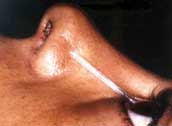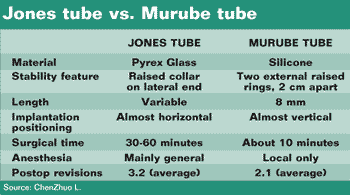Study: Murube tube offers advantages over Jones tube for lacrimal occlusions
In addition to a shorter surgical procedure, patients implanted with Murube tubes required fewer postoperative revisions.
Implantation of a Murube tube may be an economical and more stable alternative to a Jones tube for correcting occluded lacrimal pathways, according to a study comparing the two prostheses.
 |
 The Murube tube is inserted into the upper end of the cannula, pushing it through until exiting into the nostril. |
Lucia ChenZhuo, MD, PhD, an oculoplastic and reconstructive surgeon in practice in Madrid, presented a study comparing the two tubes in a poster presentation during the 14th Congress of the European Society of Ophthalmology.
She told Ocular Surgery News in an interview that both tubes are effective for restoring lacrimal flow without causing severe complications. Compared to Jones tubes, however, Murube tubes require a more simple surgical technique and provide better stability postoperatively, she said.
Implantation of a tubular prosthesis is necessary when occluded lacrimal pathways cannot be reopened by dacryocystorhinostomy (DCR), she said.
She said Jones tubes generally require longer operations that involve opening the maxillary and lacrimal bones, similar to a DCR. Additionally, she said many Jones tubes displace nasally and come into contact with the nasal septum, becoming obstructed. This results in patients generally needing additional follow-up with the surgeon several times a year, and it may require removal of the tube after several years.
Based on the results of the study, Dr. ChenZhuo said she feels Murube tubes should be used over the Jones tubes. Dr. ChenZhuo said the inconvenience of having permanent tearing due to the occlusion of the lacrimal canaliculi or the lack of lacrimal sac compensates for having a permanent tube between the inner canthus of the eye and the nose.
Additionally, Murube tubes do not require bone perforation because they run from the lacrimal caruncle to the nasal vestibulum, through the muscular layer of the face, she said.
“My opinion is that Jones tubes do not compensate these inconveniences in many cases, but Murube tubes do compensate in most cases,” she said.
Implantation procedures
According to the study, 30 eyes of 26 patients who had irrecoverable damage to the upper lacrimal pathways were randomly assigned to be implanted with either a Jones tube or a Murube tube.
The cause of the damage was extensive viral canaliculitis in six cases, ocular cicatricial pemphigoid in five cases, Stevens-Johnson syndrome in three cases and trauma in five cases. Lyell syndrome, epithelioma excision, radiation and chemical caustication each caused one case, and the cause was unknown in the remaining seven cases.
According to the study, placement of a Jones tube is initially similar to a DCR. The cutaneous is opened and the medial canthus is exposed. The ascendant branch of the maxillary bone is opened, allowing access to the nasal mucosa and leading to the nasal fossa. The anterior part of the middle turbinate is removed if necessary, followed by suturing of the mucosal flaps.
The caruncle is excised by passing a knife from the caruncular wound to the posterior of the sutured flaps. A lacrimal probe is then inserted adjacent to the knife until contacting the nasal septum.
 |
The Jones tube is fixed to the medial canthus using a silk suture under the tube collar, which can be removed after 2 to 3 weeks.
According to the study, surgical placement of Murube tubes requires only local anesthesia applied to the medial third of the face.
The surgery begins with infiltration of the face between the caruncle and the homolateral vestibulum nasi. The trocar is introduced and moved upward in the homolateral nostril. Once it is deep within the vestibulum of the nose, the trocar laterally perforates the ala nasi and moves upward over the anterior surface of the maxillary bone.
The terminal blade of a wide L-shaped knife then is introduced through the supero-anterior caruncular surface to receive the trocar point and guide it through the caruncle. The trocar is removed, leaving the cannula in position.
According to the study, the inferior end of the Murube tube is inserted into the upper end of the cannula, pushing it through until exiting into the nostril. The cannula can then be removed.
The tube is fixed with a 6-0 suture that forms a loop around the tube and is knotted in the anterior surface of the lid. The inferior excess of the tube is cut off, leaving only 2 mm to 3 mm inside the vestibulum nasi. The sutures can be removed after about 10 days.
Surgical results
According to the study, the implantation procedure for a Jones tube lasted between 30 minutes and 1 hour. Ten of the 15 patients required general anesthesia. Six cases were performed in a day hospital, and nine cases required an overnight stay following the operation.
For the Murube tube, the implantation procedure lasted about 12 minutes on average. All 15 cases required local anesthesia, although all cases were done in a day hospital.
According to the study, one Jones tube had to be removed because of an obstruction caused by mycosis from an Aspergillus fumigatus infection. In the Murube tube group, there were two cases of obstruction caused by desiccated mucus and one case caused by desiccated methylcellulose artificial tears. The tubes were cleared using irrigation or passing a knotted monofilament through the tube.
According to the study, patients implanted with the Murube tube required fewer postop revisions. Jones tube patients required an average of 3.2 revisions while Murube tube patients required an average of 2.1 revisions.
Ganuloma and hypertophic conjunctiva occurred in two Jones tube patients and two Murube tube patients.
Infection occurred in one Jones tube patient and two Murube tube patients. Despite treatment with both local and general anti-infectives, the tubes had to be removed to clear the infections, and the Jones tube was not replaced. However, the Murube tubes were replaced after 2 weeks, the study authors wrote.
After 1.5 years of follow-up, 11 of the 15 Jones tube cases remained functioning while all 15 Murube tube cases remained functioning.
Economical alternative
Dr. ChenZhuo said the Murube tubes offer several advantages over the Jones tubes. The operation is more economical because it can be done under local anesthesia and takes about 12 minutes on average, she said.
The surgeon also does not need to maintain an inventory of a complete set of tubes to be able to choose the appropriates size for a particular operation. The Murube tubes are available in only one size, which is cut to the appropriate length at the end of the procedure, she said.
Another advantage is the position of the Murube tube, which is almost vertical, while the Jones tube is horizontal, she said.
Dr. ChenZhuo said the raised silicone ring on the outer surface of the tube is grasped by the scar of the deep facial tissues, which helps avoid displacement.
“But if for any reason the tube moves outwards, it moves up but not back where it could touch the eyeball. Conversely, when Jones tubes displace, the tubes move laterally and can touch the conjunctival medial trigonus or the cornea, which could potentially injure the ocular surface,” she said.
Dr. ChenZhuo noted there is a learning curve when beginning to implant Murube tubes. When the trocar enters the nostril, pierces the soft tissues of the nose behind the ala nasi and runs through the soft tissues of the face in the direction of the caruncula, the trocar must always touch the anterior surface of the maxillar bone, she said.
“An important second advice is to open the caruncle with an L-shaped 2.8-mm cataract knife when the point of the trocar is near the caruncle. This facilitates the exteriorization of the point of the trocar just in the caruncle,” she said.
Dr. ChenZhuo said the Jones tubes would be advantageous to use during a programmed DCR, if the surgeon discovers a saccal tumor. In this instance, the surgeon has already opened the bone to the atrium nasi and has extensively removed the tissues. She said in this case the Jones tube can be placed through the osteotomy, which has already been made.
For Your Information:
- Lucia ChenZhuo, MD, PhD, can be reached at Ocular Surface Center, Cullen Eye Institute, Baylor College of Medicine, Houston, TX 77030 U.S.A.; +(1) 713-628-0209; fax: +(1) 713-798-1457; e-mail: lucychenzhuo@yahoo.com. Dr. ChenZhuo has no financial interest in the products mentioned in this article.
